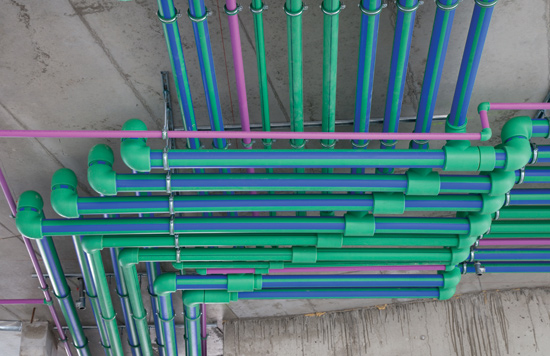Polypropylene-Random (PP-R) Piping Systems Serve Multiple Applications
Learning Objectives:
- Summarize the unique features and benefits of polypropylene-random PP-R) piping for pressure systems.
- Evaluate the different types of PP-R piping and their applications.
- Identify design issues to be considered while planning PP-R piping systems.
- Discuss the unique features and methods required for efficient installation.
Credits:
Piping systems are an integral part of virtually every building from residential towers and manufacturing facilities to hotels, data centers and healthcare centers. Since pipe failure can result in costly repairs and replacements, potential health hazards and significant environmental impact, appropriate pipe selection is a critical decision.
For the past 200 years, pipe materials have ranged from cast iron, steel and concrete to copper and polyvinyl chloride (PVC). For the last decade, engineers in North America have been given a new option: engineered polypropylene-random (PP-R.) Now installed in multiple projects across the U.S. and used throughout Europe for the past 40-plus years, PP-R has multiple benefits. It is one of the longest lasting and most chemically inert piping materials in the world.
Corrosion-resistant, chemically safe, sustainable and reliable, with an insulation value, PP-R is also code compliant, cost effective and can be integrated with other pipe materials such as copper and steel. Its applications include potable water, heating and cooling distribution (hydronic), condenser water, industrial and chemical process applications, water conservation and fire sprinkler systems.
What is PP-R?
Manufactured from polypropylene-random polymer, PP-R is a thermoplastic made up of chains of carbon and hydrogen. It is both simple and chemically stable and does not contain harmful chemicals or react with its surroundings. The “R” in PP-R refers to the random blend of long and short hydrocarbon chains that provides both rigidity and flexibility, resulting in a material with strong structural properties that can still bend enough to absorb impact and deflection. As a hydrophobic material, meaning that it repels polarized molecules like H2O, PP-R does not interact with water. It does not corrode, is very erosion-resistant even in slurry applications, and will not leach, wear out or clog up after a few years of service. Even hard water will not affect PP-R.

Photo courtesy of Aquatherm
Engineered polypropylene-random (PP-R) pipe is used for a variety of applications in North America.
PP-R has natural insulation properties that reduce and dampen noise created by water flow and water hammer. The strong bonds created by thermal fusing allows the pipe to absorb the shock and force from pressure surges and water hammer without the need for water hammer arrestors or thrust blocking.
Some pipe manufacturers develop and blend their own proprietary PP-R material for different pipe applications. Some of these product offerings are also heat-stabilized to protect the pipe from long-term exposure to temperatures that would damage other plastics.
PP-R pipe and fittings are fully recyclable, which allows any scrap material to be diverted away from the landfill.
Recycled pipe can be ground, melted and re-used in car parts, home products, food packaging and other applications. There are no harmful waste products created by the processing or disposal of PP-R.
To facilitate integration with other systems such as copper, steel and cross-linked polyethylene (PEX), a wide range of transition fittings are available. These transitions include threaded adapters, PEX adapters, copper stub-outs, flanges and groove adapters.









